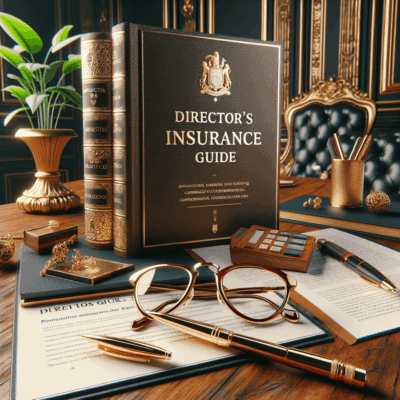Understanding and Securing the Best Directors Liability Insurance
Serving on a board of directors is a position of immense responsibility and honour. It signifies trust, expertise, and a commitment to steering an organization toward success. However, this leadership role is not without its perils. In today’s litigious business environment (especially APAC), directors and officers are increasingly exposed to a wide array of potential lawsuits from shareholders, employees, regulators, competitors, and other third parties. Allegations of mismanagement, breach of fiduciary duty, negligence, or failure to comply with laws and regulations can arise even from decisions made in good faith. The financial and reputational consequences of defending against such claims can be devastating, both for the individual and the organization.
This is where Directors and Officers (D&O) Liability Insurance becomes not just a prudent safeguard but an essential component of sound corporate governance. For any individual in a leadership position, understanding and securing the best possible D&O coverage is paramount. This comprehensive guide will navigate the complexities of D&O insurance, helping you identify the key features of a superior policy and make an informed decision to protect your personal assets and professional reputation.
What is Directors and Officers (D&O) Liability Insurance?
At its core, D&O insurance is a specialised liability coverage designed to protect the personal assets of corporate directors and officers, and sometimes their spouses and estates, in the event they are sued for alleged wrongful acts while managing a company. It is a financial safety net that covers the costs associated with defending against lawsuits and any resulting settlements or judgments.
A standard D&O policy is typically structured in three parts, often referred to as “Sides” or “Insuring Agreements”:
- Side A: Directors and Officers Liability – This is the most critical component. It provides direct coverage to individual directors and officers when the company is legally unable or unwilling to indemnify them. This can happen if the company is insolvent or if local laws prohibit indemnification for certain acts. Side A protection is the last line of defense for personal assets.
- Side B: Company Reimbursement – This side reimburses the corporation for the costs it incurs when it does indemnify its directors and officers pursuant to its bylaws or an indemnification agreement. It effectively makes the company whole for expenses it pays on behalf of its leaders.
- Side C: Entity Securities Liability – This provides coverage for the corporation itself when it is named as a co-defendant in a securities lawsuit (e.g., shareholder class actions alleging misrepresentation in financial documents). This is more common for publicly traded companies but can also apply to private companies undergoing fundraising.
Why is D&O Insurance Absolutely Essential in NZ?
The risk landscape for directors and officers has expanded dramatically. The notion that only large, public companies face litigation is a dangerous misconception. Organizations of all sizes and across all sectors are vulnerable.
Key sources of claims include:
- Shareholders/Investors: Alleging mismanagement of funds, poor strategic decisions, failure to maximize shareholder value, or misrepresentation in financial disclosures.
- Employees: Claims of wrongful termination, discrimination, harassment, or retaliation. These are among the most frequent sources of D&O claims.
- Competitors: Allegations of unfair business practices, intellectual property theft, or poaching key employees.
- Regulators and Government Agencies: Inve
stigations and actions by bodies like the SEC, EPA, or DOJ for regulatory non-compliance.
- Creditors and Customers: Claims of fraudulent trading or breach of contract, especially if a company becomes insolvent.
- Cybersecurity Breaches: As data breaches become more common, directors and officers are increasingly being held personally accountable for failing to implement adequate cybersecurity measures.
Without D&O insurance, individuals would have to pay for their own legal defense out-of-pocket. Given that defense costs alone can easily run into hundreds of thousands or even millions of dollars, a single lawsuit could lead to personal bankruptcy. Furthermore, the absence of robust D&O coverage can make it significantly harder to attract and retain high-caliber talent for your board, as savvy executives will rightfully be wary of serving without adequate protection.
Key Features of a Top-Tier D&O Policy
Not all D&O policies are created equal. The “best” policy is one that provides comprehensive protection tailored to your organization’s specific risks. When comparing quotes and policies, pay close attention to these critical features:
1. Broad Definition of “Wrongful Act” and “Claim”
The policy should define a “Wrongful Act” broadly to include actual or alleged errors, misstatements, omissions, neglect, or breaches of duty. Similarly, a “Claim” should be defined to include not just formal lawsuits but also written demands, administrative proceedings, investigations, and criminal proceedings (where insurable by law).
2. Robust Side A Difference in Conditions (DIC) Coverage
This is a crucial enhancement. A Side A DIC policy acts as a top-up layer that fills in gaps in the primary D&O policy. It is designed to drop down and provide coverage when the primary policy limits are exhausted or when a coverage dispute arises with the primary insurer. For individual directors, this is an invaluable extra layer of security.
3. Full Prior Acts Coverage and Non-Rescindable Side A
“Prior Acts” coverage ensures that wrongful acts that occurred before the policy inception date are covered, as long as the claim is made during the current policy period. A “Non-Rescindable” Side A provision means that the insurer cannot rescind coverage for individual directors and officers, even if the company application contained misrepresentations. This protects innocent individuals from the company’s mistakes.
4. Entity Coverage for Non-Profit and For-Profit Organizations
Ensure the policy clearly defines what entity coverage is included. For private and non-profit companies, this often extends beyond securities claims to include employment practices liability, fiduciary liability, and other entity-level claims.
5. Defense Costs Outside the Limit of Liability
In some policies, the immense costs of mounting a legal defense can erode the policy’s limit of liability, leaving little to nothing for a settlement. The best policies state that defense costs are paid in addition to (outside of) the limit of liability, preserving the full amount for any indemnification payments.
6. Hammer Clause Absence or Mitigation
A “Hammer Clause” gives the insurer the right to force a settlement. If the insured refuses a settlement the insurer recommends and chooses to fight the claim, the insurer’s liability may be limited to the amount of the proposed settlement. The best policies either lack this clause entirely or have a “soft” hammer clause that shares the risk more equitably.
7. Broadest Possible Exclusions
Exclusions are the ways an insurer can deny a claim. Scrutinize them carefully. While standard exclusions exist (e.g., for fraud, personal profit, or bodily i
njury), the best policies have narrowly tailored, clear exclusions without overly broad or ambiguous language that could be used to deny a legitimate claim.
8. Crisis Management and Public Relations Coverage
A lawsuit is not just a financial event; it’s a reputational crisis. Some advanced policies include sub-limits for hiring public relations firms to manage the fallout and protect the company’s and individuals’ reputations.
How to Choose the Best Policy for Your Needs: A Step-by-Step Guide
Securing the right D&O policy is a process that requires careful analysis and expert guidance of our team. We’re impartial and find the best possible directors liability insurance to suit your requirements. Far too many companies are paying excessively for their insurance which is we specifically offer directors insurance that suits you best.
1. Conduct a Thorough Risk Assessment:
Begin by honestly evaluating your organization’s specific risk profile. Consider your industry, size, financial health, stage of growth, number of employees, merger and acquisition activity, and international exposure. A tech startup will have different risks than a long-standing manufacturing firm or a non-profit charity.
2. Work with a Specialized Broker:
Do not attempt to navigate the D&O market alone. Engage an insurance broker or advisor who specializes in executive liability and has deep relationships with multiple A-rated carriers. Their expertise is invaluable in structuring the right program, negotiating terms, and explaining complex policy language.
3. Compare Insurers, Not Just Premiums:
While cost is a factor, it should not be the primary driver. The financial strength (e.g., A.M. Best rating), claims-paying history, and reputation of the insurer are far more important. You need an insurer that will be there for you when a complex, multi-year claim arises.
4. Carefully Analyze Policy Wordings:
Your broker should provide you with specimen policies or detailed summaries of coverage. Compare the key features outlined above across different insurers. Pay particular attention to the definitions, exclusions, and the specific terms of the insuring agreements.
5. Determine Appropriate Limits of Liability:
There is no one-size-fits-all answer for how much coverage is enough. Limits are typically purchased in layers of $1 million, $5 million, or more. Factors to consider include your company’s assets, revenue, the industry’s litigation trends, and what is standard for similarly sized peers. Your broker can provide benchmarking data to guide this decision.
6. Understand the Retention (Deductible):
The retention is the amount the insured must pay before the insurance policy begins to pay. Higher retentions generally mean lower premiums, but you must ensure the company can comfortably afford to pay the retention if a claim occurs.
7. Review Annually:
Your D&O policy is not a “set it and forget it” purchase. Your business evolves, and so do your risks. Conduct an annual review with your broker before renewal to ensure your coverage remains aligned with your current operations and the evolving legal landscape.
Highly Recommended Insurers in the D&O Market
The D&O insurance market is populated by numerous carriers, but a few consistently receive high marks from brokers and risk managers for their financial stability, claims handling, and policy features. While the best insurer for you depends on your specific situation, the following are often recommended for their strong presence and expertise in this niche:
- AIG (American International Group): A global giant with a massive capacity for writing large, complex D&O programs, especially for public companies.
- Chubb: Known for its high-quality policy wordings, broad coverage features, and excellent claims service across a wide range of organization types.
- Fidelity: A leading provider we love working with who not only offers comprehensive policies but also great support.
- Travelers: A market leader in the matter of D&O for private and non-profit companies, offering strong, customizable policies.
- Beazley: A specialist Lloyd’s of London insurer renowned for its innovative policy language and expertise in handling complex claims, including those related to cyber liability.
- AXA XL: Another strong player with robust offerings for both public and private entities, often praised for its underwriting expertise.
It is crucial to remember that this is not an exhaustive list, and many other excellent insurers that also provide strong D&O products. The key is to have your broker market your risk to a panel of these top-tier carriers to find the best fit. Thats where we fit in so get a quote today.
Conclusion: An Investment in Leadership and Peace of Mind
Directors and Officers Liability Insurance is far more than a line item on a budget; it is a fundamental pillar of responsible corporate governance. It protects the individuals who dedicate their time and expertise to guiding organizations, ensuring that they can make decisions based on what is best for the company’s long-term health, not on a fear of personal financial ruin.
Securing the best D&O insurance requires a proactive, informed approach. By understanding the critical components of a policy, conducting a diligent risk assessment, and partnering with a knowledgeable insurance professional, you can secure a policy that provides robust, reliable protection. This investment not only safeguards personal assets but also reinforces the stability of the organization, enhances its ability to attract top-tier leadership, and provides the peace of mind necessary for effective, forward-thinking governance. In an unpredictable world, that certainty is invaluable.
Frequently Asked Questions
Q: What is directors and officers (D&O) liability insurance?
A: D&O insurance is a type of coverage that protects the personal assets of a company’s directors, officers, and other key leaders if they are personally sued for alleged wrongful acts while managing the organization. It covers legal fees, settlements, and other defense costs.
Q: Why do I need D&O insurance for my company?
A: Even with the best intentions, leaders can face lawsuits from employees, shareholders, competitors, or regulators over decisions that lead to financial losses, alleged mismanagement, or employment practices issues. D&O insurance is crucial to attract and retain top talent, as it protects their personal wealth, and to safeguard the company’s financial health.
Q: What factors should I consider when choosing the best D&O policy?
A: Key factors include the policy’s coverage limits, the breadth of coverage (including side A, B, and C), the insurer’s financial strength and reputation, the specifics of the policy’s exclusions, the size of the deductible, and the overall cost of the premium.
Q: Are there any common exclusions in a D&O insurance policy?
A: Yes, most policies exclude coverage for illegal acts committed with intentional dishonesty or for personal profit, fraudulent acts, bodily injury or property damage (which is covered under other policies like General Liability), and pending or prior litigation known before the policy inception.





